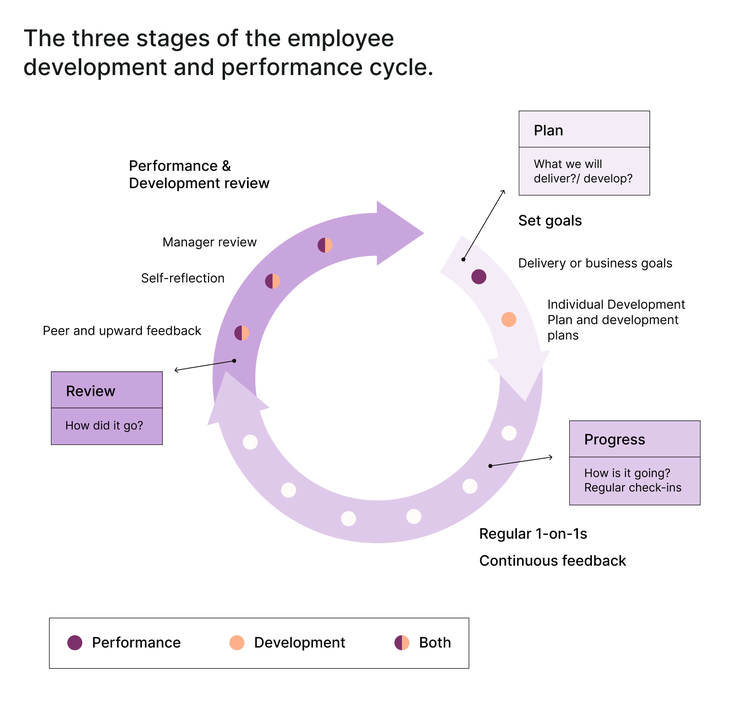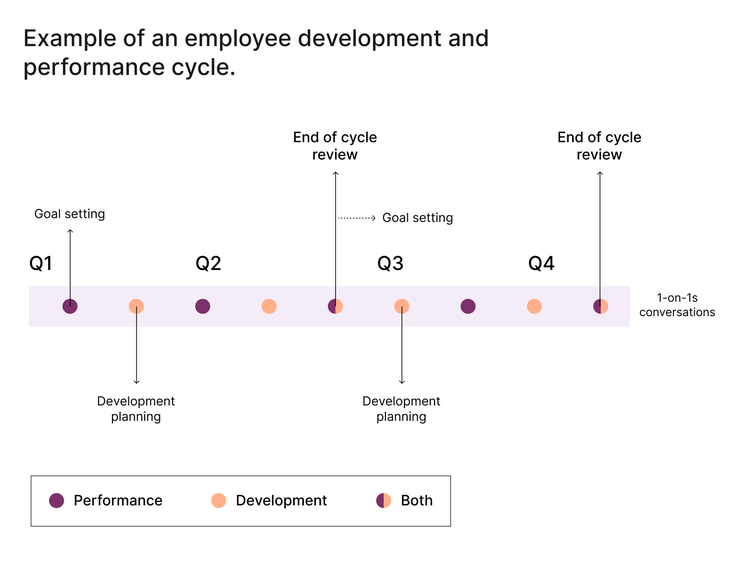
Article

Written by

The employee experience platform
While performance and development often go hand-in-hand, this workplace duo thrives with a little bit of space. During performance reviews, employees are often more interested in discussing the possibility of a promotion or compensation increase than focusing on how they can grow professionally. Plus, peer reviewers are often less likely to share candid, constructive feedback when they fear it could jeopardize a colleague or teammate’s eligibility for a raise or bonus.
When performance and development conversations are grouped together, development often falls out of the spotlight. Fortunately, just moving your development conversations a few days after a performance review can give your employees the time they need to return with an open mindset. This brief break between discussions can help your employees be more receptive to identifying their development areas, as well as listening to and learning from feedback.
Before we go any further, we want to stop and say that we’re not saying performance and development should be strictly segregated. Instead, we urge your business to think of them as two parts of a cycle that work in tandem with one another. Combining these two conversations, meaning having your managers discuss both performance and development during annual reviews, can negatively impact the employee experience because employees will focus more on the former than the latter. That said, you need to strike a delicate balance – putting them too far apart can duplicate efforts for managers, mentors, and employees, leaving your workforce too frustrated to take these conversations seriously.
Here’s a more in-depth look at why we recommend keeping performance and development separate while still pairing them together, and how your business can create an employee development cycle that offers employees structure, support, and guidance.
Before we jump into the stages of the employee development cycle, let’s first discuss why it’s beneficial for your business to conduct performance and development conversations close together. Here are some of the top reasons to ensure that your performance and development cycles are in sync with one another:
While performance looks backward and development looks forward, these two areas share more similarities than differences. Both performance measurement and development are intrinsic motivators that push your employees to do their best work. That’s why having your development conversations shortly after a review can be extremely valuable for employees.
During the review process, your employees and managers are already discussing skills, strengths, and interests – all factors that influence development goals. With these top of mind, employees will show up to development conversations with a better understanding of their current career aspirations. When employees are prepared for these conversations, your managers can get right to the point: creating a career development plan to carry that employee from where they are now, to where they want to be in the future.
After a performance sync, a manager and their direct report typically work on goal-setting for the next review period. Before this happens, encourage managers to have their development conversations, so the outcome of those conversations can be incorporated into the goal-setting process.
While an employee needs professional objective and key results (OKRs) to understand how their manager will evaluate their performance, they also need personal development goals to motivate them and hold them accountable. For that purpose, ask your managers and employees to wait until after their development conversations before moving forward with goal-setting. This will ensure development remains top of mind for the pair throughout the entire review period.
Every business wants to build a workplace where each employee feels valued, and one of the easiest ways to show employees you care is by investing in their development. Your company should want every individual to see their role within your company as a career, not a job. Whether your employee stays for 10 months or 10 years, you want them to look back and recognize how much they learned and grew with your company.
While performance reviews are great for evaluating employee performance, a review that offers nothing but positive feedback can be demoralizing. Employees crave feedback – they want to learn how they can be the best version of themselves and reach the next level of their career. If they aren’t getting that at your organization, they’ll find somewhere that challenges them. In fact, 94% of employees believe they would stay with a company for a longer period if it showed interest in their learning and development.
Conducting both performance reviews and development conversations proves to your employees that you’re invested in their careers and committed to helping them grow within your organization – and beyond. Your managers and mentors just need to ensure that this isn’t the only time of year they offer employees feedback. A successful employee development cycle depends on frequent progress check-ins between employees and managers, so they can receive feedback and proactively implement changes into their daily work.
Don't know where to start? In our experience, many companies already have a performance cycle in place but haven't yet developed a development cycle. To help you out, here are the 3 basic steps of the employee development/performance cycle and how to talk your employees through each of them.

In the Plan stage, your employees determine what they will do in the cycle ahead. Performance and development goals should be formed separately, meaning managers and employees establish both business goals and individual development goals to work towards for the period.
While your business goals can follow whatever goal-setting framework your business uses, like SMART goals or OKRs, your development goals will want to ladder up to an action plan. To build an action plan, we recommend having your employees first determine the skills and behaviors they need to work on to achieve their objective(s). Encourage them to focus on one growth area at a time, to set goals and actions, and share their final action plan with one key individual – either their manager or their mentor.
This stage is the longest of the cycle as it encompasses the informal check-ins and conversations your employees and managers/mentors have during the period. Throughout this time, your employees will be exchanging continuous feedback, sharing progress updates, and adjusting their performance and development goals as needed. This helps keep everyone on the same page and allows your employees to listen to feedback and incrementally improve throughout the performance/employee development cycle, rather than waiting until the end to make a change.
The end of the performance/development cycle is when our two separate conversations take place. The performance review always comes first and evaluates an employee’s performance for the given period. During this stage, each employee receives manager, peer, and self-reflections that cover both performance and development, so each reviewer only has to fill out a single form one time. Ask your managers to conduct two conversations within a few days of each other to keep this information top of mind. Remember, performance conversations look back and summarize the last review period, while development conversations are future-focused and leave employees with a concrete understanding of how to progress towards their dream role.

Development and career growth both motivate your employees to do their very best. By building performance/development cycles that are in sync, your business can create an effective feedback loop that drives higher performance among your people.
But, building a culture of continuous feedback and development is no small feat. Empowering employees with actionable development plans, trackable goals, and ongoing learning opportunities can be challenging without the right software in place. Learn more about how your business can invest in employees’ professional growth with Develop by Culture Amp.
